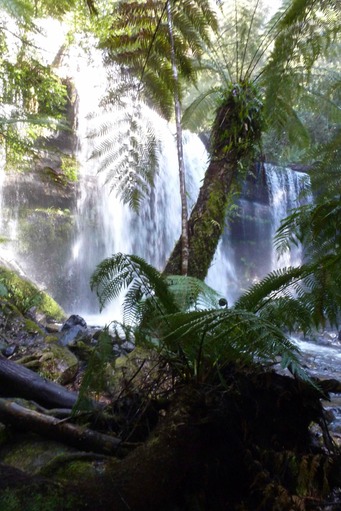Heading back to Westerway we made the right hand turn towards Mount Field, with silence the rule as The Driver negotiated the twists and turns on the road and Hughesy pondered the railway line that cut across the road at regular intervals. There was never any issue with actual trains or boom gates and such (each railway crossing sign pointed out the line is not currently in use).
Hughesy the closet train freak, however, couldn't help what had brought the line into the district in the first place. Timber was the most likely candidate, though I harboured a suspicion that it might have led to Queenstown and Strahan. A subsequent glance at the map reveals that's not the answer. If the line had continued up to Maydena, from there it would have run into an almost impossible obstacle in the form of the mountainous cool climate rainforests of the Franklin Gordon Wild Rivers National Park.
If it wasn't timber the other possibility that sprang to mind, once we'd handed over our $24 at the Visitors Centre, was tourism.

Located on the eastern boundary of Mount Field National Park, Russell Falls has been a popular tourist attraction since the mid-1880s. Tasmania’s first nature reserve was established to protect them in 1885, and Mount Field was declared a national park in 1916. Originally discovered around 1856 and named Brownings Falls after the original discoverer, the name was changed in 1884, by which time they were already a popular tourist attraction. In 1899, the Falls were chosen as one of eight images for a set of postage stamps promoting Tasmania's tourist industry.
Nineteenth century visitors could catch a train from Hobart to the nearby town of Westerway (known as Russell at the time) and cover the rest of the journey in a horse-drawn carriage. Charles Marriott purchased operated a six room guest house on the banks of the Russell (Tyenna) River adjacent to the Falls Reserve from 1908, with his wife Mabel catering lunch at the guesthouse for travellers.
When the railway line (presumably the one I’d been bemused by) was extended to National Park in 1917 the increased flow of visitors had Marriott extending the guest house by an additional thirty rooms. The guest house was destroyed by fire in the 1960s.
Madam had to head back to the car to which the permit sticker on the windscreen. Given the weather conditions I was attracted by a lightweight insulated waterproof jacket, significantly marked down to $49. Away from the display rack, however, they weren't such an attractive proposition, so the concept was fairly promptly scratched.